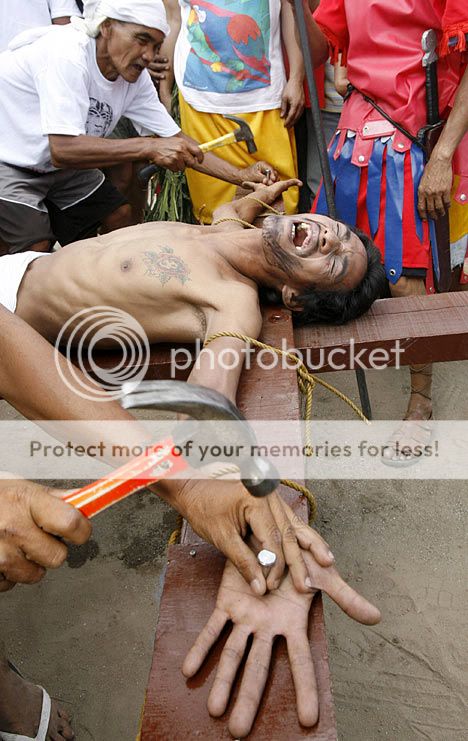The Holy Week in the Philippines is observed to commemorate and honor the Paschal Mystery - The Passion, Death, Resurrection and Ascension to Heaven of our Lord Jesus Christ to redeem mankind. Here are some of the traditional practices during Lent by many Filipinos:
 |
| The crucifixion is still being practiced by some devotees during the Lenten Season as penitence. |
1. Palm Sunday - The whole family go to mass for the blessing of the Palaspas, the palm leaves. People buy decorated palm leaves and have it blessed by the officiating priest after the mass then take it home to be displayed on the altar or hung above doorways, usually the front door until the next Palm Sunday. Old beliefs say it could ward off bad spirits but now, it's actually being done out of tradition and also as reminder of Jesus' entry to Jerusalem.
2. Holy Monday, Holy Tuesday and Holy Wednesday - Also by tradition, some families host the Pabasa or Pasyon, a non-stop 3-day vigil of singing and chanting of the Passion, Death and Resurrection of Christ. There is a certain melody used in the chanting that veteran Pasyon singers are sometimes invited in shifting schedules complete with guitarists and other musicians. Be that as it may, some opted to change the melody to attract the participation of the youth. Spiritual Retreats are also organized by different parishes, starting Holy Monday to Holy Wednesday.
4. Biernes Santo (Good Fiday) - This is the day when you will see many street processions all over the country, reenacting the Way of the Cross or the Senakulo, which is actually a stage play. During the procession, many devotees, women included, who self-flagellate, carry heavy wooden cross and have themselves nailed on the cross as self-sacrifice for penance. This is repeated every Lent as a panata (pledge). Good Friday is believed to be the day that the Lord died on the cross at the holy hour of 3 o'clock in the afternoon, therefore the Sietes de Palabras, The Seven Last Words are also incorporated in the Senakulo.
In the evening, there are funeral processions all over the country of the image of the 'Dead Christ,' the Prusisyon ng Sto. Entierro. The lying image of Jesus is placed in a glass on a lighted carriage decorated with flowers, followed by the images of the crying ladies, Mater de Dolorosa, Mary Magdalene, Mary of Cleophas, Mary of James, Salome, and also John the Evangelist. The women during the procession wear veils and sometimes get emotional and cry too.
5. Sabado de Gloria (Black Saturday) - This is a day of mourning to symbolize that the 'Christ is Dead.' People refrain from merriment and making any noise. TV and radio stations usually do not broadcast live from Good Friday to this day, many establishments even malls, cease their operation also to pay respects. Some parishes reenacts Hudas Eskariote's betrayal of Jesus and hanging of self.
6. Pasko ng Pagkabuhay (Easter Sunday) - This is a joyous celebration for the 'Risen Christ,' marked by the Salubong, the meeting of the Mother and Child after His Resurrection, usually held at 12 midnight or early dawn. The life size images of the veiled Blessed Virgin Mary and the Resurrected Christ will be in procession with separate routes, the women following the image of the Mother while the men, the Christ. They will meet in a designated area where a stage had been constructed signifying the Galilea. The procession will be accompanied by singing and children wearing angel costumes. Upon meeting, the Virgin Mary's purple veil will be removed by an 'angel' singing Regina Caeli, Queen of Heaven. This signifies the end of grieving because the Savior has risen. The unveiled Blessed Mother is also now transformed to the
Nuestra Senora de Alegria or the Our Lady of Joy. There would be ringing of bells and fireworks. The parishioners would then proceed to the Church for the Easter mass. Parishioners sometimes prepare the Agape feast, breakfast for everyone who attended the Salubong. Other activities are also lined up during the day including the Easter Egg Hunting for children.
"I am the resurrection.
Whoever believes in me though he die, shall live.
Whoever lives and believes in me will never die.
Happy Easter!








Very interesting... and some of it is rather disturbing. I thought it was only shia muslims who would inflict physical pain on themselves as a tradition.
ReplyDeleteHi JT!
ReplyDeleteThanks for visiting.
Yes, self-inflicted pain during Lent as penitence is still a very much alive tradition in the country. Although the Church do not really encourage it. I guess, people just have different ways of saying sorry :)
By the way, I'm excited about your Bloggers Tips Blogging Challenge. I'll submit my entry soon.
There are really bunch of tourists visited Pampanga.
ReplyDeleteHi Bradpetehoops!
ReplyDeleteAre you from Pamapanga? Very nice place and the culture is very much alive too. The people are friendly and the food are just heavenly!
These are the reasons why many local and foreign tourists visit your province not only during the Lenten Season.
Thanks for reading my post. I hope I can visit your province again to taste the authentic Pampango's Pork Sisig and my favorite Fried Hito with Buro and Mustasa side dish :)